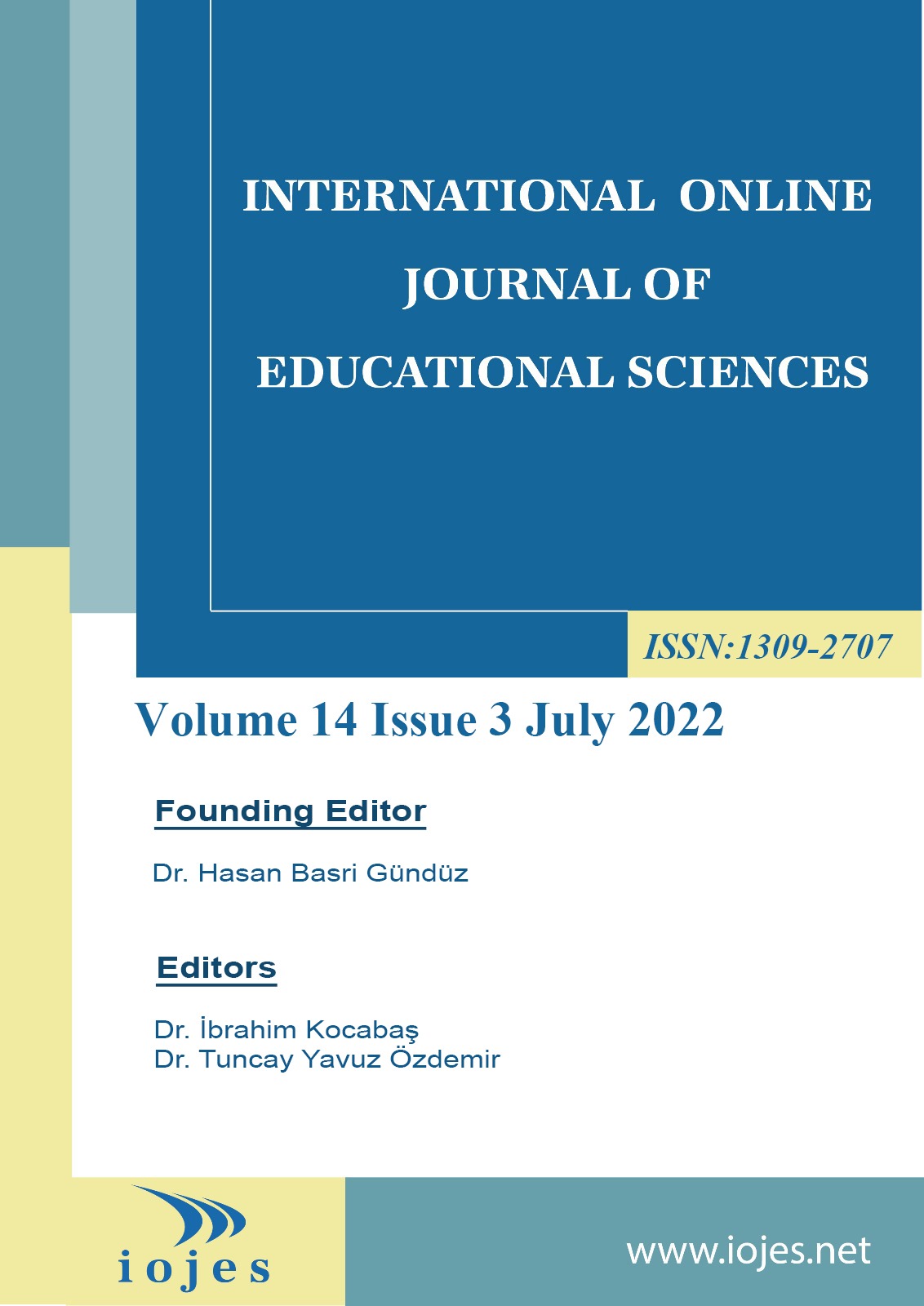Evaluation of Secondary School 7th Grade Science Skill-Based Questions According to the Revised Bloom Taxonomy
Author :
Abstract
Keywords
Abstract
The aim of this research is to evaluate the 7th grade science skill-based questions published by the Ministry of National Education of the Republic of Turkey in the 2019-2020 academic year, according to the revised Bloom taxonomy. In this study, document analysis method, one of the qualitative research methods, was used. The data of the research consists of 7th grade science skill-based questions published by the Ministry of National Education in the 2019-2020 academic year. In the study, 143 science questions were evaluated according to the revised Bloom taxonomy. Each of the aforementioned questions was examined separately and it was determined which levels they belong to in the "cognitive process" and "knowledge" dimensions of the revised Bloom Taxonomy. When the questions were evaluated according to the cognitive process dimension of the revised Bloom taxonomy, it was determined that the questions were stacked on the levels of understanding and application. When the questions were evaluated according to the knowledge dimension, it was determined that the questions were stacked on the levels of procedural knowledge and conceptual knowledge. While the majority of the questions (86.71%) are related to low-level skills, only 13.29% of them are related to high-level skills.
Keywords
- Akanngbe, J. M., & Enero, U. J. (2015). Classification of end- of- chapter questions in senior school chemistry textbooks used in Nigeria, Electronic Journal of Science Education, 19(7), 1-16.
- Akpinar, E., & Ergin, O. (2006). Evaluation of written exam questions of science teachers, Journal of National Education, 172, 225-231.
- Akyurek, G. (2019). Examination of LGS and TEOG exams according to science curriculum and renewed bloom taxonomy, Master Thesis, Necmettin Erbakan University, Institute of Educational Sciences, Konya.
- Amer, A. (2006). Reflections on Bloom revised taxonomy, Electronic Journal of Research in Educational Psychology, 4(1), 231-230.
- Anderson, L. W., Krathwohl, D. R., Airasian, P., Cruikshank, K., Mayer, R., Pintrich, P., & Wittrock, M. (2001). A taxonomy for learning, teaching and assessing: a revision of Bloom taxonomy, New York.
- Ayvaci, H. S., & Turkdogan, A. (2010). Analysis of science and technology course written questions according to the reconstructed Bloom taxonomy, Turkish Journal of Science Education, 7(1), 13-25.
- Bloom, B. S., Engelhart, M. D., & Furst, E. J. (1956). Taxonomy of educational objectives: The classification of educational goals, Handbook 1: Cognitive Domain, New York: David Mckay.
- Bowen, G. A. (2009). Document analysis as a qualitative research method, Qualitative Research Journal, 9(2), 27
- Bumen N. T. (2006). A milestone in curriculum development: revised bloom taxonomy, Education and Science, 31(142), 3-14.
- Gunduz Y. (2009). Analysis of 6th, 7th and 8th grade science and technology questions according to measurement tools and Bloom cognitive domain taxonomy, Yuzuncu Yil University Journal of Education Faculty, 6(1), 150-165.
- Guven, C. (2014). Examining the questions in the 6th, 7th, 8th grades science and technology curriculum according to the revised Bloom taxonomy, Master Thesis, Ahi Evran University, Institute of Science and Technology.
- Guven, C., & Aydin, A. (2017). Examining the questions in the 8th grade science and technology curriculum according to the cognitive process dimension of the revised Bloom taxonomy, Journal of the Turkish Chemical Society, 2(1), 87–104.
- Hitchcock G., & Hughes D. (1995). Research and the teacher: A qualitative introduction to school based research (2nd Ed.), London: Routledge
- Ilhan, A., Tutak T., & Ekinci, N. (2021). A study on the relationship between mobbing and professional burn out perceptions of secondary school mathematics teachers, Shanlax International Journal of Education 9, 88-104
- Iskamya U. (2011). Analysis of pre-service science teachers' questioning preferences and questions asked in secondary education entrance exams according to Bloom taxonomy, Master Thesis, Canakkale Onsekiz Mart University, Institute of Educational Sciences, Canakkale.
- Krathwohl, D. W. (2002). A Revision of Bloom taxonomy: an overview, Theory into Practice, 41(4), 212-218.
- Miles, M. B., & Huberman, A. M. (1994). Qualitative data analysis: An expanded sourcebook, Thousand Oaks, CA: Sage Publications.
- Nakiboglu, C. & Yildirir, H. E. (2011). Analysis of Turkish high school chemistry textbooks and teacher - generated questions about gas laws, International Journal of Science and Mathematics Education, 9, 10471071.
- Nayiroglu, B. Tutak, T., & Tutak A. M (2021). Review of the views of secondary school maths students on skills-based questions, Shanlax International Journal of Education, 9, 105-111.
- Roohani, A., Taheri, F. & Poorzangeneh, M. (2013). Evaluating four corners textbooks in terms of cognitive processes using Bloom Revised Taxonomy, Research in Applied Linguistics, 4(2), 51-67.
- Saglamoz, F. & Soysal Y. (2021). An investigation of the outcomes of 2018 primary science course curriculum according to the revised Bloom taxonomy, Istanbul Aydın University Education Faculty Journal, 7(1), 111145.
- Sahinel, S. (2002). Eleştirel düşünme. Ankara: Pegem Yayıncılık.
- Sanca, M., Artun H., Bakirci, H. & Okur, M. (2021). Evaluation of secondary school skill-based questions according to the restructured bloom taxonomy, YYU Journal of Education Faculty, 18(1), 219-248,
- Seo, Y. J., Kim, H. S., & Chae, H. K. (2010). Analysis of the end-of-chapter questions in chemistry II according to revised Bloom taxonomy of educational objectives, Journal of the Korean Chemistry Society, 54(3), 329
- Tanik N. & Saracoglu S. (2011). Examination of science and technology course written questions according to the revised Bloom taxonomy, Journal of Turkish Science Research Foundation, 4(4), 235-246.
- Tsaparlis, G., & Zoller, U. (2003). Evolution of higher vs. lower-order cognitive skills-type examination in chemistry: implications for university in class assessment and examinations, University Chemistry Education, 7(2), 50-57
- Tutkun, O. F. (2012). An overview of Bloom revised taxonomy, Sakarya University Journal of Educational Sciences Institute, 1(3), 14-22.
- Yesilyurt, E. (2012). Evaluation of pre-service teachers' competency in writing test situation questions about cognitive domain, Kastamonu Journal of Education, 20(2) 519-530.
- Yildirim, A. & Simsek, H. (2008). Qualitative research methods in the social sciences, Ankara, Seckin Publishing.
